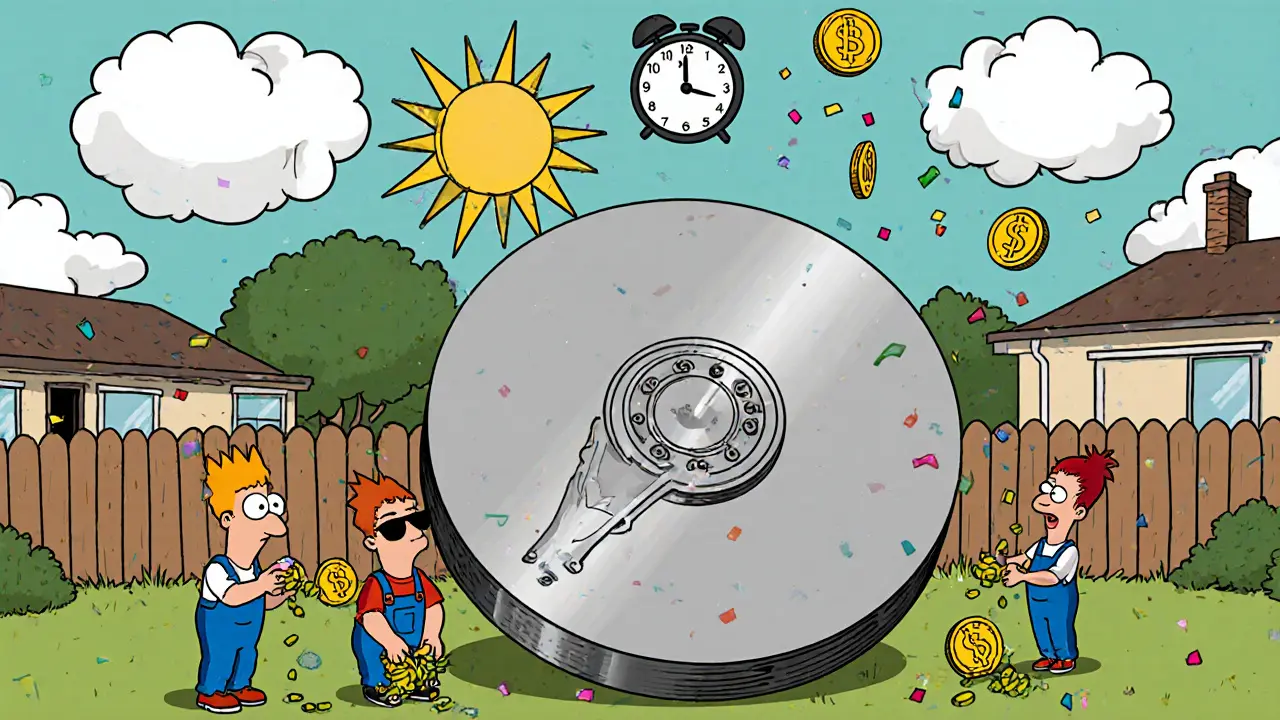Spacemesh Mining Earnings Calculator
Estimate how much SMH you could earn by allocating disk space to the Spacemesh network. Based on current market conditions and network participation.
Estimated Earnings
SMH Per Day:
USD Value (Current: $0.0021):
Daily Cost Savings (vs Bitcoin):
SMH Per Month:
Total Value (30 Days):
Equivalent to:
How Your Earnings Compare
| Method | Storage Required | Estimated Earnings (10GB) | Energy Cost |
|---|---|---|---|
| Spacemesh (SMH) | 10GB | 0.0001 SMH | Minimal (0.001W) |
| Chia | 1TB | 0.001 SMH | Low (10W) |
| Bitcoin | ASIC Miner ($2,000+) | 0.00001 SMH | Extremely High (1000W) |
| Ethereum | 32 ETH ($102,400) | 0.00005 SMH | Negligible |
Important Note: These are estimates based on current network conditions. Actual earnings may vary significantly due to:
- Network participation levels
- SMH token price fluctuations ($0.0021 as of November 2025)
- Storage allocation efficiency
Most people think mining crypto means buying expensive machines that guzzle electricity. But what if you could mine cryptocurrency using just the free space on your hard drive-no fancy gear, no power bills, no noise? That’s the promise of Spacemesh (SMH), a crypto project built to let anyone with a regular computer join the network and earn rewards.
Spacemesh Isn’t Like Bitcoin or Ethereum
Bitcoin mining is a race. The person with the most powerful ASIC miners wins the block reward. Ethereum used to be the same-until it switched to proof-of-stake, which now requires you to lock up $100,000 worth of ETH just to participate. Neither of those models is friendly to everyday people. Spacemesh was created to fix that. Instead of using electricity to solve math puzzles, Spacemesh uses disk space. It’s called Proof of Space-Time (PoST). You don’t need a GPU farm or a warehouse full of mining rigs. You just need free storage on your laptop, desktop, or even an old external drive. The more space you give, the more often you get rewarded with SMH tokens. This isn’t just a gimmick. Spacemesh’s developers spent five years building the protocol from scratch. Their goal? Make mining fair. No big mining farms. No centralization. Just ordinary users contributing storage and getting paid for it.How Spacemesh Mining (Smeshing) Actually Works
The process is called “Smeshing.” Here’s how it works in plain terms:- You install the Spacemesh app (called SMAPP) on your computer.
- You set aside a portion of your unused hard drive space-starting at just 10GB.
- The app uses that space to generate cryptographic proofs that get checked by the network every few minutes.
- If your proof is valid and selected, you earn SMH tokens.
Why Spacemesh Is Environmentally Different
Bitcoin’s annual energy use is bigger than some countries. Ethereum’s switch to proof-of-stake cut its energy use by 99.95%. Spacemesh takes it further. Proof of Space-Time doesn’t burn electricity. It uses disk storage, which draws minimal power-about the same as leaving a smart bulb on. That’s why Spacemesh fits perfectly under new global rules like the EU’s MiCA regulation, which pushes crypto projects to reduce energy use. Spacemesh’s team says their system uses less than 0.1% of the energy Bitcoin does per transaction. That’s not marketing. It’s math. Hard drives spin slowly, use watts, not kilowatts. No cooling needed. No fans screaming. You can Smesh on a laptop while you work, stream, or sleep.
SMH Token: What You Get and How It’s Distributed
SMH is the native token of the Spacemesh network. It’s used to pay for transactions, reward Smeshers, and eventually power smart contracts. As of November 2025, SMH trades around $0.0021. The 24-hour trading volume is low-just under $2,000-which means it’s not liquid yet. You won’t find it on Coinbase or Binance. It’s listed on only 12 smaller exchanges. There’s a pre-mine-meaning some tokens were allocated to early developers and investors before the public launch. Exact numbers aren’t public, but the team says the majority of tokens are meant to be earned by Smeshers over time. That’s different from many other coins where founders hold most of the supply. The tokenomics are designed to reward long-term participation. The more you Smesh, the more SMH you earn. And unlike staking, you don’t have to lock up your coins. You can earn and spend freely.How Spacemesh Compares to Other Projects
Spacemesh isn’t the only crypto project using storage. Chia Network also uses proof-of-space. But here’s the difference:| Project | Consensus | Hardware Needed | Energy Use | Minimum Entry | Block Time |
|---|---|---|---|---|---|
| Spacemesh (SMH) | Proof of Space-Time | Hard drive space | Very low | 10GB storage | 10 seconds |
| Chia | Proof of Space | Hard drive space | Low | 1TB storage | 30 seconds |
| Bitcoin | Proof of Work | ASIC miners ($2K-$15K) | Extremely high | $2,000+ hardware | 10 minutes |
| Ethereum | Proof of Stake | 32 ETH ($102,400) | Negligible | $100,000 stake | 12 seconds |
Challenges Spacemesh Faces
Despite the tech being solid, Spacemesh has big hurdles. First, awareness. Most people have never heard of it. Second, liquidity. With only $2,000 in daily trading volume, it’s hard to buy or sell SMH without moving the price. Third, storage limits. A 2023 MIT study found that only 37% of internet users have more than 1TB of free space. That’s not a problem for Spacemesh’s 10GB minimum-but if the network grows, users might need more space to stay competitive. There’s also the risk of “space-sharing.” Someone could rent out huge amounts of cloud storage to dominate Smeshing. Spacemesh’s protocol has defenses against this, but it’s still a theoretical weakness. And then there’s the competition. Thousands of crypto projects are trying to be the next big thing. Spacemesh doesn’t have a flashy NFT marketplace or meme coin hype. It’s quiet, technical, and focused on long-term decentralization.
What’s Next for Spacemesh?
The roadmap is ambitious-and realistic.- Q2 2026: Smart contracts will launch. This means you’ll be able to build decentralized apps (dApps) on Spacemesh.
- Q4 2026: Cross-chain bridges will let you move SMH to other blockchains like Ethereum or Solana.
- Version 3.1 (late 2025): Zero-knowledge proofs will be added for private transactions.
Should You Try Spacemesh?
If you’re curious, it’s free to try. Download SMAPP, allocate 10GB, and leave it running. You won’t get rich. But you’ll earn SMH tokens without spending a dime on electricity or hardware. It’s not a get-rich-quick scheme. It’s a quiet experiment in fairness. If you believe crypto should be open to everyone-not just those with deep pockets or access to cheap power-then Spacemesh is worth a look. Right now, it’s early. The network is small. The price is low. But the technology is real. And if it grows, early Smeshers could be the ones who helped build something truly different.Frequently Asked Questions
Is Spacemesh mining safe for my computer?
Yes. Smeshing uses your hard drive space, not your CPU or GPU. It runs in the background with minimal impact on performance. Your computer won’t overheat, slow down, or wear out faster. It’s designed to work like a background app-similar to how a cloud backup service runs.
How much SMH can I earn per day?
It depends on how much space you allocate and how many others are on the network. With 10GB, you might earn a fraction of a SMH per day. With 1TB, you could earn several SMH daily. Rewards are calculated automatically and paid out every 10 seconds. There’s no guesswork.
Can I mine Spacemesh on a phone or tablet?
No. The SMAPP app only works on desktop operating systems: Windows, macOS, and Linux. Phones don’t have enough stable storage or the right file system access for reliable Smeshing.
Do I need to keep my computer on all the time?
To earn consistently, yes. If your computer is off, you won’t be able to submit proofs. But you don’t need to leave it running 24/7 if you’re okay with earning less. Even a few hours a day adds up over time.
Where can I buy or sell SMH?
SMH is listed on 12 smaller exchanges like BitMart, MEXC, and Gate.io. You can’t buy it on Coinbase, Binance, or Kraken yet. Always check the exchange’s reputation before trading. Due to low volume, prices can swing quickly.
Is Spacemesh a scam?
No. The protocol is open-source, with code publicly available on GitHub. The team has been active since 2018, and major investors like Coinbase Ventures have backed it. The low trading volume doesn’t mean it’s fake-it just means it’s early. Be cautious of fake websites or apps claiming to be Spacemesh. Only download SMAPP from the official site.
